#freshwater article
Text
Monster High: Gillington Webber's Profile
Despite being one of the first characters to be introduced into the Monster High franchise, Gil wasn't given a proper profile for a long time. By the time one was released, it wasn't in a website format like the earlier releases for character profiles. With that, this article will feature Gil's full profile.


Parent: The River Monster
Age: 16
Killer Style: I wear shorts, flip-flops and T-shirts to make me feel like I fit in on land. But my helmet means I can't ever wear anything tight round the neck.
Freaky Flaw: I have a certain amount of fear of the open sea...
Favourite Activity: Swimming!
Biggest Pet Peeve: I totally can't bear it when my monster parents dictate what I have to do.
Favorite School Subject: Maths. When I grow up I want to be a hydro engineer. So I'll need maths for that.
Least Favorite School Subject: Horror Literature. I'd rather read textbooks than novels.
Favorite Color: Blue, like crystal-clear water.
Favorite Food: Seaweed. I know it sounds slightly exotic for a freshwater monster, but it tastes freakily good!
Pet: Right now I don't have one, but I really dote on Lagoona's pet piranha, Neptuna.
BFF's: Lagoona Blue and Clawd Wolf.
#gillington webber#gil webber#monster high#river monster#character profile#article#generation 1#freshwater monster
16 notes
·
View notes
Text
I think that's why I really like passive collectors rather than mechanized collectors. The bandalong we use to keep litter from flowing into larger bodies of water is easily avoided by aquatic life and even provides fish cover as a bonus. It also provides habitat for spiders who love to crawl up my leg while im cleaning the encatchment basins 🥲 We've found tons of turtles, snakes, and frogs living in or under the structure as well. It also helps us study what kinds of waste are more likely to end up in waterways and how much.
This is a bandalong btw
I agree with the researchers that we can't rely on marine robots to clean up our trash and use them as excuses to not reduce plastic production. I think plastic does have valid and important uses, but 90% of it can be replicated by other more sustainable materials. Investment in alternative sustainable materials should be prioritized over trying to find a way to keep plastic production the same. Of course saying this makes oil barons unhappy so they'd rather fund cleanup robots rather than accept reducing their profits even a tiny bit.
Cleanup robots do have a place but they shouldn't be seen as a perfect miracle solution.
#wrenfea.exe#yes we need to clean up plastic#but we cant be harming marine life in the process#and we'll never put a dent in the amount of plastic in our oceans and bodies if we don't slow production#article commentary#environmental science#marine science#freshwater ecology#stream conservation#science news#environmental news
9 notes
·
View notes
Text
just cold-emailed a random biology professor bc i wanna read his benthic algae article and i didnt wanna pay science direct $30 for it, and he got back to me in like two hours and was like yeah no problem ill send it the next time im at my computer
#another win for spending 5 minutes finding someone's email instead of forking over cash for pdfs.#academics by and large hate paywalls and will just give you their shit for free <33333#im on cloud nine rn tbh. positive social interaction 👍#also this guy is liek Thee freshwater benthic algae guy#his name keeps popping up in every article i look at#be my bestie? hooray!#my post
3 notes
·
View notes
Text




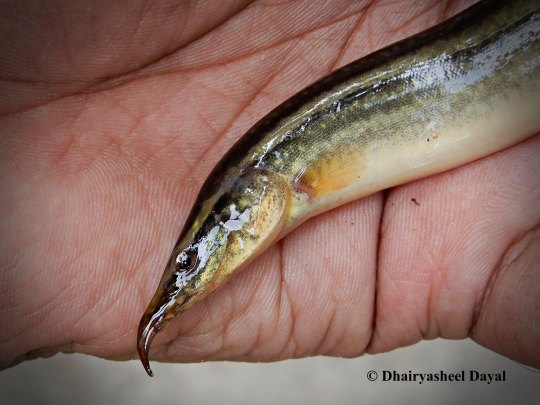
Something fishy. Our world is full of aliens.
The Macrognathus aral, One-stripe spiny eel has its mouth and anterior shaped like a bird's beak. People make artworks by combining different kinds of animals or their forms. People also wonder about aliens, how they would look, and we have had so many drawings, cartoons of aliens. But isn't our own earth, the very world where we live, comprised of creatures alien-like? We have thousands and lakhs of species, all different from one another. And if we were to pick any animal group from these, let's say, fish, even they have so much variety. This variety, again, is in their body shapes, colours, size. And they are found in different habitats - freshwater (rivers, streams, ponds, lakes), saltwater/ marine, estuary. Let's consider their looks and body features. There's this one, in this post itself - Macrognathus aral, One-stripe spiny eel - which has a bird's beak-like anterior. There're 'flying fish' that can fly or glide in air for some time (with help of their fins). There're 'frogfish'. From their name itself, one can understand that they must be appearing like frogs. Walking on the seafloor. 'Sole' are flat fish that can be observed, again, on the seafloor, and with both of their eyes on one side (facing upward), on contrary to the single eye on each side of the fish. There are anglerfish, which lure their prey with their luminescent part. And so many others, grouped together based on their 'usual' characteristics, but still 'unusual'. Our world itself is full of aliens!
- Dhairyasheel Dayal
#Macrognathus aral#One-stripe spiny eel#sole#sole fish#flat fish#flatfish#fish#fish variety#biodiversity#wildlife#animals#animal species#frog fish#anglerfish#flying fish#earth#planet earth#aliens#aliens on earth#freshwater fish#freshwater#marine fish#aquatic#aquatic life#aquatic wildlife#eel#animal forms#short articles#article#beak
2 notes
·
View notes
Text
#writerslife#women writers#writer things#articles#writerscommunity#aquarium#fish tank#freshwater fish#fishes#fish#aquatic life#marine life#marine biology#bloggingcommunity#blogpost#blog post#blogger#blog#girl blogger#tumblog#tumbler#blogging#wordpress#wordporn#wordsmith#word
1 note
·
View note
Text
Hey... so there now appear to be AI-generated science articles on .org websites that are giving biologically incorrect "facts" on basic, for-children topics
The title is "Are There Freshwater Octopus Species?" which should be an incredibly straightforward thing to answer: No.
The article starts out decent:
"Despite their many fascinating features, there is no evidence to suggest that octopuses can survive in freshwater environments."
Cool. Okay. Next section.
"While most people associate octopuses with the ocean, there are some species that can survive in freshwater environments."
Wait. What?
"Freshwater octopuses belong to the genus Amphioctopus, which includes several species that are found in brackish water and estuaries. These cephalopods have adapted to life in freshwater environments and have been observed in rivers, streams, and even hydrothermal vents."
NO NO NO.
One species of freshwater octopus is Amphioctopus aegina...Another species, Amphioctopus marginatus...
THESE GUYS LIVE IN THE OCEAN.
[Scrolls 2 more sections]
Freshwater octopuses are still a topic of debate among scientists. While some researchers claim that they do exist, others argue that there is not enough literature to support their existence.
asd;lkfjasdlf;kjasd;flksjdfa
#science#it's so sus like I don't believe this was vetted by a real person#maybe the output was briefly skimmed by someone who was ESL and they just okayed it?#ai#this is extremely bad for kids
26K notes
·
View notes
Text
So I've been encountering a few people who think it's a great idea to essentially treat AI (actually, language models) as some sort of oracle in their spiritual path, so I wanna mention:
An AI-generated article recently claimed that freshwater octopuses were a thing. They aren't.
AI-generated foraging books contain deadly misinformation.
Microsoft acknowledges that AI gives wrong answers all the time; defends it by saying that they're "usefully wrong." Yeah, nah, wrong is wrong.
So yeah, do not use AI to try and divine any absolute truths about anything; it literally cannot work for this function. The only thing AI can tell you about is what its datasets already contain, which very likely contains a substantial amount of misinformation and errors; and AI is more than capable of remixing accurate information into complete baloney.
294 notes
·
View notes
Text
Gharial rescued from sea
Another instance of more recent croc news, a "giant" gharial was found in the Indian Ocean off the coast of Balsore, eastern India.
According to news articles, the animal, an adult Indian Gharial (Gavialis gangeticus), meassured around 13 feet or in metric close to 4 meters in length while weighing some 118 kilos.

The gharial apparently got caught in a fishing net and was found by fishermen, who promptly reported their catch to the Forest Department. The department then handed the animal over to Nandankanan Zoological Park, where the crocodilian still resides.
That's all the information given to us by the article, which you can read here, but there's two key notes I wanna touch upon.
The first is size. At 4 meters, this gharial was decently large for sure and as someone who has seen a (stuffed) female of slightly greater proportions I can attest that it must have been an impressive animal. However, I think its worth mentioning that Indian gharials are capable of growing even larger. The female I just mentioned is accompanied by a stuffed male nearly 5 and a half meters in length, with some reports claiming sizes even greater than that.
Me and the Vienna gharials

The second point is the mysterious presence of a gharial this far out at sea. This is simultaneously unusual yet also very much reasonable from the point of view of paleontology.
On the one hand, Indian gharials are critically endangered. Their range today is incrediply spotty and isolated and to my knowledge they aren't found anywhere near the coast these days.
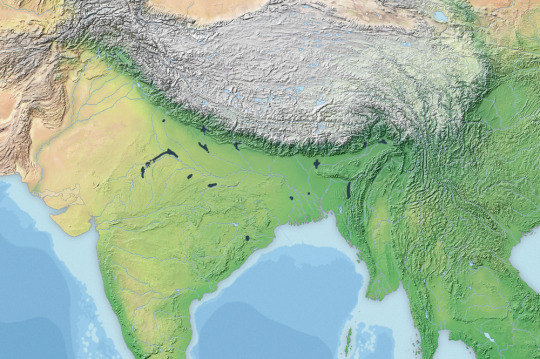

However when you look at how the range was meant to be like, then you see that they definitely reached the river deltas and coastal regions. So our image of gharials as this inland freshwater species is more based in circumstance than reality.
This becomes especially apparent once you begin to consider the paleobiogeography of gharials. Based on our current knowledge, gharials most likely originated somewhere in Eurasia or Africa, spreading from there across much of the eastern hemisphere and beyond (full disclosure I am not considering thoracosaurs to be gavialoids, more on that can of worms later maybe). Anywho, phylogenetic analysis and the fossil record both suggest that gharials then crossed oceans and settled South America sometime prior to or during the Miocene, where they diversified and gave rise to the gryposuchines. Some species even remained saltwater species, such as Piscogavialis, which lived in the coastal waters of Peru.
Although gryposuchines were once thought to be a distinct subfamily of gharial, recent research suggests that they were but an evolutionary stepping stone, with some South American form once again crossing the Pacific and settling down in Asia where the much more basal "tomistomines" or false gharials (a misnomer) still resided. And while the gryposuchines of South America went extinct, those that returned to Asia survived and eventually gave rise to the Indian Gharial of today.
Left: A cladogram showing the relationship between Gryposuchinae and modern gharials
Right: Piscogavialis swimming overhead some marine sloths of the genus Thalassocnus by @knuppitalism-with-ue


So ultimately, seeing a gharial in saltwater is much less bizarre than one would initially think, its just that habitat destruction and overhunting have largely pushed these gorgeous reptiles further inland and to the brink of extinction.
#gharial#indian gharial#gavialis gangeticus#gavialidae#news#croc#crocodilia#crocodile#india#herpetology#gavialinae#gryposuchinae#piscogavialis#some paleontology#palaeoblr
241 notes
·
View notes
Text
Content warning: This article includes scenes of physical and sexual harassment and assault.
The trouble in Antarctica started in Boston. It was August 1999, and Stanford geologist Jane Willenbring was then a 22-year-old self-described “country bumpkin.” She had just arrived to start her master’s in earth science at Boston University. As an undergrad with an oboe scholarship at North Dakota State University, she’d studied beetle fossils found in Antarctica and learned how, millions of years ago, the now frozen continent once pooled with freshwater lakes. “That’s not so different from the conditions we might expect in the future,” she says. She wanted to explore this critical science. “It seemed really important for future global climate change,” she says.
Of all the geologists, few were more renowned than the one Willenbring had gone to Boston to study under: 37-year-old David Marchant. Marchant, a scruffy professor at BU, was a rock star of rock study. He was part of a research group that rewrote Antarctic history by discovering evidence of volcanic ash, which showed that Antarctica had been stable for millions of years and was not as prone to cycles of warming and cooling as many thought. To honor his achievements, the US Board on Geographic Names approved the naming of a glacier southwest of McMurdo Station, the main research base on Antarctica, after him.
Willenbring says Marchant had insisted on picking her up at the airport, an offer she thought was nice but strange. It got stranger when he started making her feel bad for his gesture, which she hadn’t asked for. “I’m missing a Red Sox game,” she recalls him chiding her. “You really should have picked a better time to fly.” He asked whether she had a boyfriend, how often she saw him, and whether she knew anyone in Boston or would be alone. In a few months, she’d be heading with him on a research trip to Antarctica and the region with his big chunk of namesake ice. “It was almost like a pickup line,” she recalls, “‘I have a glacier.’”
But it’s what happened in the glacier’s shadow that led Willenbring to take on Marchant and become the first to expose the horrors faced by women at the bottom of the world. A report released in August 2022 by the National Science Foundation, the main agency funding Antarctic research, found that 59 percent of women at McMurdo and other field stations run by the US Antarctic Program said they’d experienced sexual harassment or assault. A central employer, Leidos, holds a $2.3 billion government contract to manage the workplaces on the ice. One woman alleged that a supervisor had slammed her head into a metal cabinet and then attacked her sexually. Britt Barquist, a former fuel foreman at McMurdo, says she had been forced to work alongside a supervisor who had sexually harassed her. “What was really traumatic was telling people, ‘I’m afraid of this person,’” she says, “and nobody cared.”
With a congressional investigation underway, Willenbring is sharing her full story for the first time with the hope of inspiring others to come forward and claim the justice they’ve long deserved. But even now, decades after she first got into Marchant’s car, she can’t help asking herself how, and why, the nightmare happened in the first place. “You never hear a women-in-science panel where people are talking about stuff like I do,” she says, “because they’re smart enough to fucking run.”
146 notes
·
View notes
Text
"Spitting Out Water Babies"
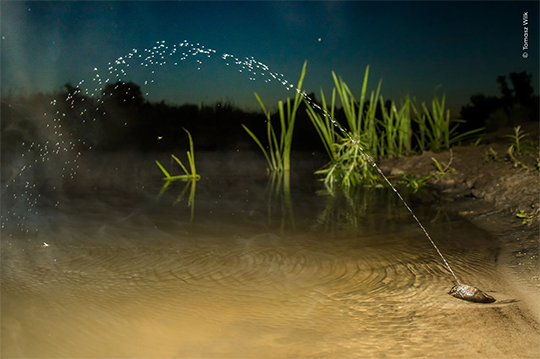
When Tomasz Wilk settled to camp one evening on the banks of a Polish river, he didn't expect to find fountains in the shallows. Though reminiscent of an archer fish's shot, this stream comes from a freshwater mussel. (Image credit: T Wilk; via Wildlife POTY)
Read the full article
93 notes
·
View notes
Text
It’s a week before the finale and so I’m figuring out how the fish aquatic mammals (see my Telchin evolution post for details) can breathe air, freshwater, saltwater, and live on both land and the bottom of the ocean, which are questions I’ve had since we’ve met Ulysses. This post is going to be a bit more biological process/science communication heavy, but I’ve linked my sources where applicable.
First, lets talk about the gills. Gills are tissues that are filled with thin blood vessels called capillaries. As water is passed over the gills, oxygen diffuses from the oxygen-rich water into the oxygen-deficient blood. This works because particles/gasses/etc like to move down their concentration gradient, from areas of high concentration to areas of low concentration.
To have a consistent supply of oxygen, water needs to be constantly flowing over the gills. This is easy to do while the Telchin are swimming, but when they’re not, my thought is that the ear fins flap to push water down past the gills.
In order to live on the bottom of the ocean, Telchin would have to deal with the pressure difference. Marine mammals in real life can dive down to 2,000 feet, and they are able to mitigate the change in pressure using a number of adaptations. The main one which I think the Telchins use is the collapsing/contracting of the lungs and other airways to prevent them from imploding under the pressure. They also would have thicker/more insulated skin to help with the cold that comes with the deep ocean.
The salinity (amount of salt) of the environment is important to any organism, but especially to aquatic animals. Salmon and American eels, however, are two species that travel from saltwater to freshwater over the course of their life cycles. Salmon (and by extension, the Telchin) can do this because of a number of adaptations, most importantly a molecular pump in the cell walls of the gills that pump salt out of the blood when they’re in saltwater and into the blood when they’re in freshwater.
As far as I know, only lungfish breath both air and water. They are almost the reverse of Telchin, having started out with gills and then evolving a primitive sort of lung. Telchin have both lungs and gills, so they can mechanically breath both air and water, but my question is how they change from breathing water to breathing air. My hypothesis is that when the O2 levels in their blood are too low, they switch methods of breathing.
Your body already senses the amount of oxygen (I tried to find a suitable popular source for this and failed, so this is a scholarly article, just so y’all know) in the blood, and responds when O2 levels are low. When a Telchins oxygen levels are low, their body will either lessen the blood flow to the gills and open up the lungs (using the same system that prevents the lungs from being crushed by the pressure) or vice versa, increasing blood flow to the gills and closing the lungs.
In summary: fish can do cool things, and therefore so can the Telchin.
64 notes
·
View notes
Text
Sonic’s World Gothic (unsorted)
You sent your penpal photos of your hometown once. She blew your phone up with questions for an hour. Human cities don’t have triple-nesting doors or Air Pits, apparently.
Researchers can’t decide how the Emeralds came to be. Past civilizations couldn’t, either. One wrote that they arrived in a meteor, splitting the earth into many islands on impact. Another told of them emerging from a lava flow, the planet’s energy pressed into solid form within its mantle. Your World History class covered every known legend, just in case.
The local Chao garden has long since been paved over. Like milk caps and grinding shoes, they took over the world for a season and vanished just as quickly. You'd knelt in the pond and taught one to swim. You miss that moment sometimes; soaking in freshwater, their putty-like paws in yours.
The fox kid pushed you out of harm’s way once. You’d thanked him after and he shrank into his own scruff, insisting it was nothing. Years later you tuned into one of his livestreams, just in time to hear him roast his brother into oblivion. They laughed with their fangs bared, and you were proud.
Someone sent their camcorder footage to news stations after the flood. It’s been seared into your mind. Dozens crowding on the tops of skyscrapers; a hundred-foot wave suspended mid-crash, crest splitting to bare teeth; deafening cheers; a blinding gold light.
You knew he’d been framed in the bank robbery. Everyone did. The question was why the reporters doubled down on it after singing his praises months earlier. That ended up being the least of your concerns that week. Most of it is a blur of panic, of history in turmoil, of unsaid goodbyes. Your clearest memory is of the moment it ended; of two stars shining where certain death once loomed. You blinked, and one star went dark.
The school rich kid brags about going to some sun festival overseas every summer. One year, he came back and was oddly quiet about it. Rumors trickled down the social ladder; something about his whole family having déjà vu. You didn’t care until later that week, when you saw an article about the festival. Nothing had gone wrong, but a dozen clergymen stepped down the next day, suddenly terrified of their own god.
People across the shattered globe told of an unlikely hero protecting them at night. Theorists went wild: Another living echidna? A rich playboy who lost their parents in the earthquakes? A wolf who sold their soul to Dark Gaia for power, then changed their mind? A reporter noted that these sightings matched up with a certain hedgehog’s travel patterns at the time, and brought it up in an interview after the fact. He claimed to have seen the mystery crusader only once, and also that they were shredded.
#sonic the hedgehog#chaos emeralds#chao#chao garden#tails#miles tails prower#sonic adventure#station square#sonic adventure 2#sonic 06#soleanna#sonic unleashed#sonic the werehog#werehog#sth#sonic's world#mobius#mobians#sa1#sa2#06#unleashed#me talking#mobius gothic#headcanons#natural disasters tw#floods tw#flooding tw
761 notes
·
View notes
Text
The Greek islands in the 50s through the lens of Robert McGabe
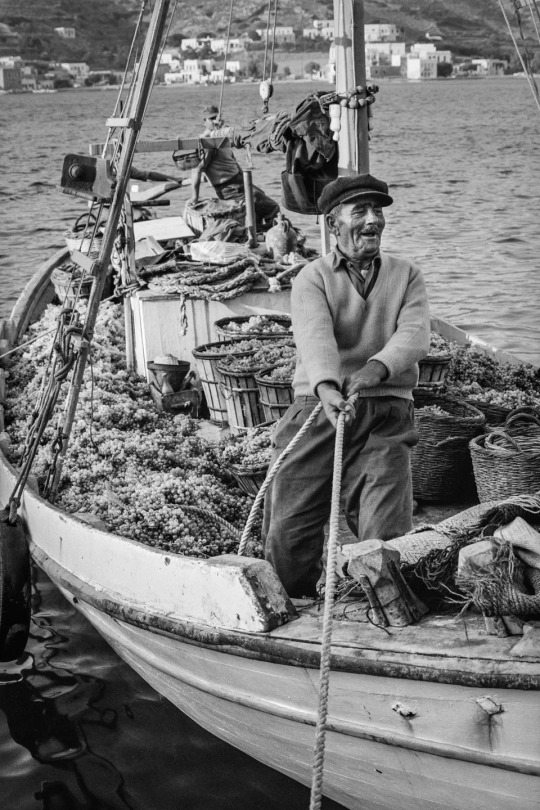
Katápola, Amorgós, 1960. Boat full of grapes arrives at the port. Due to the absence of good roads at the time, sometimes the boats were used for transfers even to different places of the same island.
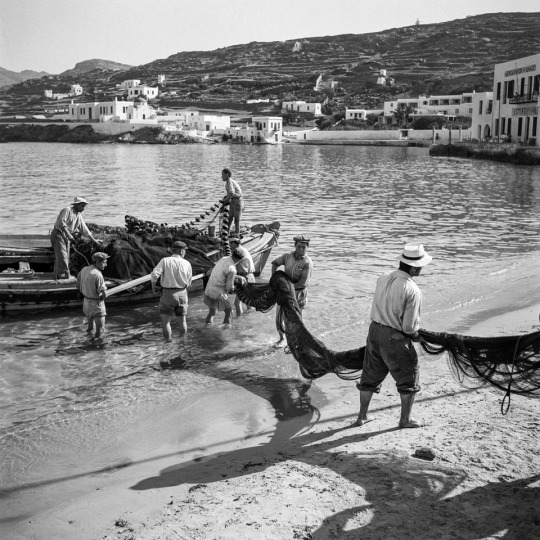
Mýkonos, 1955. Fishermen take their nets out at dawn to dry and fix them. In the background one can spot Hotel Leto, one of the two first hotels built by EOT (Greek Organisation of Tourism) in Greece.

Sérifos. Windy meeting at the Chora´s fountain.

Naxos, 1957.

Mýkonos, 1957. Serious negotiation between a farmer who brought his produce to the Chora with his donkey and the shop owner Asimina Kousathana. Note the stand with the card postals in the background.

Linariá, Skyros 1957. Women wait at the harbour for ships to bring freshwater. Many Greek islands suffer from water scarcity to this day.
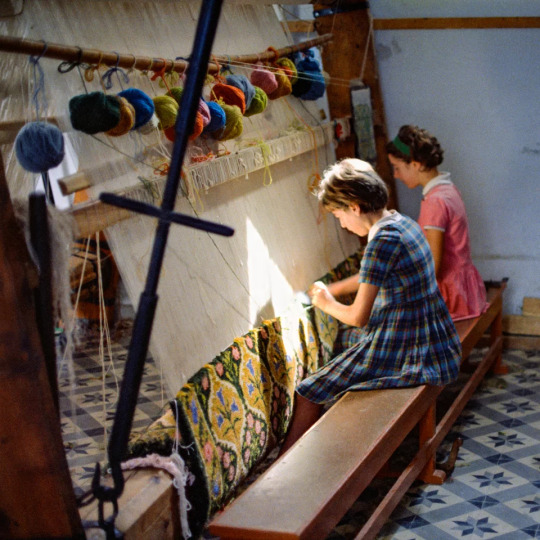
In Santorini, Father Nikolaos Kokkalakis founded the school of carpet making in order to create job opportunities for the local young women and keep them in the island.

Girl fills her tinplate with water while smiling at the camera. Mýkonos 1957.
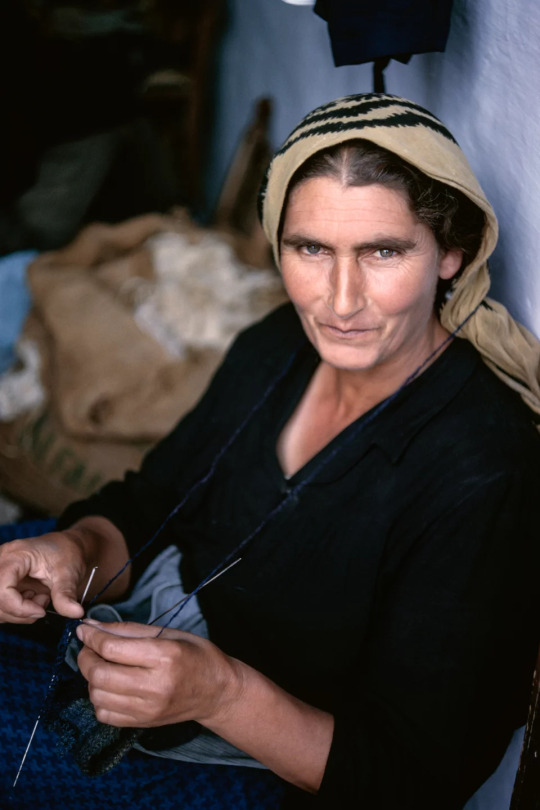
A woman knitting stares back at the camera, Skyros 1957.
Original article in Greek and with more photos here.
#greece#photography#black and white photo#black and white#old photos#retro#greek islands#mykonos#santorini#naxos#amorgos#serifos#skyros#cyclades#cycladic islands#sporades#thessaly#greek facts#long post#tw long post
171 notes
·
View notes
Note
do you know of any adjective order rules in spanish? not necessarily rules as in "anything else is wrong", but in "anything else sounds weird"
(like in english, where "brown big bear" isn't technically wrong, just... weird)
Okay FYI I ramble a lot in this, and I tried to make it clearer in places but just know that this is a lot of stuff, and I repeat myself, and though there are some rules, sometimes it's about feeling and what sounds right rather than a regular rule
Regardless of whether the adjectives go in front or in back, just know that Spanish (and English) tends to put adjectives of opinion, size, origin/nationality, color, and quality as the most important
Other adjectives like determiners take precedence always
And other adjectives are stuck to the noun as a collocation. More below.
-
There are four things I just need to say first and then we'll really get into it:
For your basic average garden variety adjectives, they typically go behind the noun like la flor hermosa "beautiful flower". If you put them in front, you're sounding extra super fancy poetic lyrical so do this sparingly or for Dramatic Flair; la hermosa flor "the beautiful flower" sounds like I'm reading poetry
There are some adjectives that change meaning depending on placement - prime example is mismo/a, where you can say la misma cosa "the same thing" vs. la cosa misma "the thing itself", where mismo/a is related to "same" or "selfsame" [like el mismísimo rey "the king himself" or "the very king himself"]. Literally it is "selfsame"... in front "same", in back "self". Another one is antiguo/a which in front often means "ancient" or "antique" or "former", while in the back it can be "old" as in "old-fashioned" or "antiquated". And bueno/a and malo/a for "good" and "bad" will constantly confuse you too
There are certain adjectives that are what we call "determiners" that are almost always in front (except occasionally for dramatic effect). A determiner is usually a specific adjective like possessive adjectives, demonstratives, adjectives of quantity (mucho/a, poco/a), and question words just to name a few. Determiners are also the definite and indefinite articles - el, la, los, las and un, una, unos, unas, and also includes numbers both cardinal [one, two, three] and ordinal [first, second, third]
A very important thing to note about adjectives is a potential "collocation" - meaning a noun + adjective that work together as a sort of cohesive unit. An example las bellas artes is "fine arts", but literally "the beautiful arts" but written fancy-like because bello/a meaning "beautiful" would typically go behind. In this case, las bellas artes is almost like a separate piece of vocab because you can't really separate them. Another would be something like el oso pardo which is "brown bear" or "grizzly bear", the adjective pardo/a refers to a brownish coloring but in this case it is stuck to oso almost like it's a specific descriptor that makes it a full "unit". These are best learned like your normal vocab, or understood as compound nouns that you can't break up... things like el agua dulce "freshwater" [instead of salt water], la sal marina "sea salt", las malas hierbas "weeds", la luna llena "full moon", el águila calva "bald eagle", el pavo real "peacock", la caja fuerte "safe/lockbox" etc etc.
-
Essentially, the adjectives are free to move around, except for when they're not
When it's your regular adjectives, you're free to say them in any order you like - they're regular descriptions, and all you need to keep in mind is potentially when y turns to e / o turns to u, and little grammatical hiccups like that:
Su ascendencia es alemana, irlandesa, e italiana. = Their heritage is German, Irish, and Italian.
Su ascendencia es italiana, irlandesa, y alemana. = Their heritage is Italian, Irish, and German.
No difference though I would personally assume the first one you mention is maybe the most important or the largest part.
Same with general descriptions:
Es un edificio notable y llamativo. = It's a notable and eye-catching building.
Es un edificio llamativo y notable. = It's an eye-catching and notable building.
Es una mujer lista y trabajadora. = She's a smart and hard-working woman.
Es una mujer trabajadora y lista. = She's a hard-working and smart woman.
Where you get into iffy territory is when adjectives come in front
I personally would say if you're using bueno/a or malo/a in front of an adjective it's one that almost always goes first except if there's a determiner:
el buen hombre = the good man
un buen hombre = a good man
este buen hombre = this good man
la buena mujer = the good woman
una buena mujer = a good woman
esta buena mujer = this good woman
Same with other determiners like cualquier buen hombre "any good man", cada buen hombre "each good man", muchas buenas mujeres "many good women" etc.
This is also something to keep in mind with collocations and set phrases:
En el Antiguo Egipto, había dos reinos distintos - Alto Egipto y Bajo Egipto, y en las épocas posteriores se unificaron, y fueron gobernados por unos poderosos reyes-dioses conocidos como los faraones.
"In Ancient Egypt, there were two different kingdoms, Upper Egypt and Lower Egypt, and in later times they united and were governed by some powerful god-kings known as the pharaohs."
So let's examine that further:
Something like el Antiguo Egipto, el Alto Egipto, el Bajo Egipto or something like el Imperio Antiguo "the Old Kingdom" of Egypt are collocations, consider them their own vocab and try not to think too hard on it because sometimes they're just set phrases like la Antigua Grecia "Ancient Greece", Gran Bretaña "Great Britain", or el Sacro Imperio Romano "the Holy Roman Empire"
A word like poderoso/a sort of becomes a more intense verison of itself changing its normal location; if it were el rey poderoso you might translate that as "powerful king" or "strong king", putting el poderoso rey adds some oomph to it and now it's "the mighty king" as if that's the most important aspect of it and it's exceptional - and regular adjectives can follow normally; el poderoso rey conocido como "the mighty king known as"
-
I should also mention that there are adjectival phrases involving de, but you've probably seen them already... like... es un libro de literatura infantil "it's a children's literature book"
I think this is more specifically like "the genitive case", which is normally used linguistically to talk about possessives or qualifiers of some kind, but they are often attached directly to the noun and tend to preempt most adjectives:
El maravilloso mago de Oz es un libro de literatura infantil estadounidense muy popular. = The Wonderful Wizard of Oz is a very popular book of children's literature.
-
...Again, just some general notes because I feel like I was rambling a lot:
Adjectives sometimes go in front or behind the noun depending on their function in the sentence
Most adjectives end up behind the noun
Determiners pretty much always go in front 95% of the time
The articles - el/la/los/las or un/una, unos, unas are the first determiner adjectives 99.999% of the time; possessives can take the place of articles... el dinero "the money" vs. su dinero "their money"
Determiners of numbers (cardinal numbers or ordinal numbers) are almost always the second adjective mentioned, even if there are other determiners... el primer paso "the firststep", mi primer paso "my first step"
Adjectives like "good", "bad", "big", and a few others are often the next adjectives if there are other determiners... el primer gran paso "the first great step" or mi primer gran paso "my first great step"
As a quick example... las tres buenas hadas "the three good fairies"... 1st is las as the article, then tres is a cardinal number, and then you have the adjective of quality "good"
Some adjectives can change meaning depending on placement - las tres buenas hadas "the three good fairies" implies that "good" is their main quality, as opposed to evil. But if you said las tres hadas buenas it comes out as "the three nice fairies" as if you're talking about personality
Keep an eye out for certain collocations and set phrases that should be treated as separate vocab and not to be separated - esta noche "tonight", la prensa rosa "tabloids" [lit. "pink press"], or la montaña rusa "rollercoaster" [lit. "Russian mountain"]
Collocations or set adjectival phrases like de can't be broken up... la luna de hoy "today's moon" vs. la luna llena de hoy "today's full moon" / and la luna de esta noche "tonight's moon" or la luna llena de esta noche "tonight's full moon"
If you're adding nationalities, they tend to show up immediately after the noun or the first noun phrase since they qualify everything - la literatura infantil popular "popular children's literature" vs. la literatura infantil estadounidense popular "popular American children's literature" or la literatura infantil francesa "popular French children's literature"
If you're doing a list of regular adjectives, you can probably put them in any order you want
But be aware that some adjectives go in front more and some go in back more, and sometimes it's a matter of style - such as el famoso oso panda chino "the (very) famous panda bear from China"
Certain qualities like "big/small", nationality, "good/bad", "elder/younger" do take priority though; as an example mi heramana inteligente "my smart sister" vs. mi heramana menor inteligente "my smart younger sister" or mi hermana pequeña inteligente "my smart little sister"
Additionally:
Adverbs always go in front of the adjective they're modifying... la familia más conocida "the most well-known family", una historia muy larga "a very long story"
Possessives in their more adjectival form ALWAYS go after the noun... su libro "their book" vs. el libro suyo "the book of theirs"; this is part of the genitive/possessives but possessives
Don't separate collocations or set phrases or things get confusing
I wish I could be more specific but this is really contextually-based and so it becomes more like give me an example and I'll tell you what I think sounds the most natural
What I can say is that you get a feel for what sounds the most natural as you go and you get more examples in your daily life of what sounds right or what just sounds a little bit off
But, Spanish-speakers probably will understand generally what you mean even if something sounds a little off as long as you don't separate the set phrases
#learning spanish#spanish#language#languages#langblr#la gramatica#asks#learn spanish#spanish grammar
120 notes
·
View notes
Text

A new genus and new species of freshwater crab (Decapoda: Brachyura: Gecarcinucidae) from the Central Western Ghats of India
SAMEER KUMAR PATI+ PARASHURAM PRABHU BAJANTRI+ GOPALKRISHNA DATTATRAYA HEGDE
Abstract
A new genus and new species of gecarcinucid freshwater crab, Aradhya placida gen. et sp. nov., is recognized from the northern part of the Central Western Ghats of India.
The new genus is diagnosed, and the new species from the Uttara Kannada district of Karnataka state, is described herein.
The new genus most resembles Arcithelphusa Pati & Sudha Devi, 2015, Cylindrotelphusa Alcock, 1909, Rajathelphusa Raj, Kumar & Ng, 2021, and Pavizham Raj, Kumar & Ng, 2022, in having an ovate, relatively narrow and deep carapace, with the front narrow as compared to other Indian gecarcinucid genera.
Aradhya gen. nov. is nevertheless separated from those genera by the characters in the carapace, epigastric and postorbital cristae, external orbital angle, cervical grooves, third maxilliped, chelipeds, male thoracic sternites/sternopleonal cavity/pleon, male second gonopod, and especially by the elongated male telson and the stouter ultimate article of the male first gonopod.
Read the paper here:
A new genus and new species of freshwater crab (Decapoda: Brachyura:Gecarcinucidae) from the Central Western Ghats of India | Zootaxa (mapress.com)
65 notes
·
View notes
Note
Every time I see nonvegans calling us racist and saying we value non human animals over humans and talking about how indigenous people are often in situations where they need to hunt to survive (despite most of the people making this argument not being indigenous themselves), I think about this video we watched in my freshwater ecology class in uni that talked about the impacts of animal agriculture on freshwater systems and the disproportionate impacts it has on indigenous communities. This video had real indigenous people talking about the real life impacts nearby animal farms have on them and their community. In it they talked about how they feared for their health, how they were seeing how the pollution animal ag. caused deteriorated their quality of life, how they would beg the farmers to not spread their animals waste on certain days and how they would catch the farmers doing so purposefully on those days.
It just makes me feel so sick seeing this primarily nonindigenous audience so self assuredly talk over indigenous voices about their own issues and pat themselves on the backs while doing things that actively support and contribute to the issue. I'm white and I would never dream of trying to have a voice in the vegan debate in indigenous spaces because it's just not my place, and yet nonvegans feel so entitled to do so and think they are fighting against racism in bulldozing over actual indigenous people.
So many of these people talk about indigenous culture and lives in such an abstract way too. It reminds me of how health teachers in schools talk about LGBT+ people. Talking about them like their existence is theoretical and purely for the sake of discussion rather than a group of real living people. It's just so dehumanizing. And yet we are the ones who don't care. Literally all I want in life is for people to care about one another and for everyone do try and do their best to live in a way that is kind to others and minimalizes harm to all living things. But the people calling that wish racist won't do the bare minimum and listen to the people saying that this industry is actively hurting them.
The really important thing to avoid getting really angry over stuff like this is to remember that it's actually just an elaborate show for them. Nobody who has done even a cursory amount of research into the biggest threats to indigenous communities would be defending animal agriculture and blaming it on vegans; its all just a performative sham.
What it comes down to is the fact that they can't deal with our argument so they try to make us somehow Problematic so that they can cloak their discomfort in the language of social justice. It's the most banal and predictable response that it's not even worth getting annoyed over. They don't actually care about indigenous people, or quinoa farmers, or whatever else is their talking point of the week; they're just playing dress-up.
The indigenous people, the farmers, the 'children picking our crops' are not real people to them, they're just pawns. Sometimes they are literally made up, as happened with the quinoa argument, which somehow evolved from a clickbait article about Peruvian farmers being priced out due to western demand, to quinoa being picked by child slaves - which was never even the claim of the original (now widely debunked) article. They actually, frequently make up slaves to get mad over rather than discussing recognising any of the real victims of animal agriculture. That is the level of cognitive disonance that we are dealing with.
This performance is mostly directed at themselves and each other, rather than us, because what we advocate for presents a challenge to their identity as good people, as social justice advocates, as leftists, as animal lovers. It's why we see so much applause for bizarre and blatantly untrue claims circulated here every week, and so much aggression over seemingly obvious, basic facts when presented by vegans. If you can understand that it is just for show then you can put it in the proper context and find it pitiable rather than infuriating.
40 notes
·
View notes